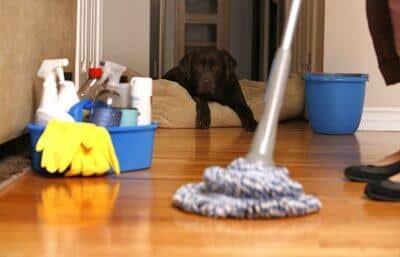
Image source: corporatemaid.com
One of the most fun kitchen science experiments I have done with my kids is the good old volcano project. As any budding scientist knows, the combination of baking soda (sodium bicarbonate) with vinegar (diluted acetic acid) generates carbon dioxide gas, and it is immensely satisfying to watch the “explosion” that results.
Did you know that you can use this “experiment” to clean your drains? You can, and you can perform some other household magic with these two common products, as well. In fact, when you add in some lemon, some water, a couple of spray bottles and some rags or sponges, you can clean your entire house. By doing so, you will you not only clean effectively, but you will avoid the harsh chemicals and the high cost of commercial household cleaners.
The acetic acid in vinegar kills and inhibits the growth of viruses, bacteria and mold. It also works to dissolve mineral deposits and stains on most kitchen and bathroom surfaces. Baking soda is useful for everything from cleaning your carpet to scouring your oven.
Before we look at some specific ways you can put these products to work in your home, here are a few points to consider.
- Before you use any new cleaner, test it on a small hidden area first to make sure no damage occurs. Vinegar’s acidity can eat away at tile grout, for example, and it is not recommended for marble. Lemon juice can act as natural bleach, so use caution with it, as well.
- Make sure the white vinegar you have is made from natural ingredients. Avoid a product if the label lists synthetic alcohol, since it is probably petroleum-based. Instead look for the words “neutral grain spirits,” “wine” or “grain alcohol,” since those products likely are made from corn, apples or grapes.
- If you are concerned about the vinegar smell lingering, don’t be. The odor disappears as it dries. Another option is to add in lemon juice or lemon peel to replace the vinegar odor with a fresh citrus scent.
IN THE KITCHEN:
You probably have a box of baking soda in your fridge to absorb odors, but there are many other uses for baking soda as well as for vinegar and lemon in your kitchen. Here are some of them:
For a general all-purpose spray for counters and floors, mix together a 50:50 solution of vinegar and water and fill a clean empty sprayer bottle with it. Add a squeeze of lemon juice, if you wish. To cut grease and kills germs, simply spray on and wipe off with a clean rag.
Story continues below video
Microwave: Heat a small bowl containing one cup of vinegar on high for three to four minutes. The vinegar and steam will loosen any built-up grime so that you can wipe it clean with a rag.
Stove fan filter: Bring water to boil in a large pan, then add one-fourth cup baking soda and mix well. Soak your fan filter in the solution for several minutes. Then turn it over, soaking that side for several more minutes. Remove, rinse and let air dry.
Dishwasher: Add white vinegar to the rinse compartment of your dishwasher to help prevent buildup on your dishes and to keep your dishwasher smelling fresh.
Cutting boards: Clean stains and disinfect your cutting board by squeezing juice from a whole lemon onto the board and allowing it to sit for about 30 minutes. Wipe clean and rinse with water.
Coffeemaker: For better tasting coffee and a better working drip coffeemaker, start a cycle the machine with a 50:50 solution of water and vinegar. Halfway through the cycle, turn the coffeemaker off and let the solution sit for about an hour. Then complete the cycle.
Kitchen drain: Call the kids to watch as you pour a half cup of baking soda followed by a half cup of vinegar down the drain. Watch it fizz as it loosens a clog. Then rinse with hot water. (You can use this in the bathroom, as well.)
Food storage containers: Squeeze some lemon juice and a bit of baking soda into the containers. Rub the mixture into any stains and let it sit overnight to remove the stains and any odors.
Tea and coffee cups or mugs: Fill mugs with a mixture of one part baking soda and two parts water and let it sit overnight. Then scrub and rinse to remove stains.
Oven cleaner: Make a thick paste of baking soda and water to apply it to any spills and burnt food inside your oven. Let the paste sit overnight. Then remove paste and wipe with a swipe of your vinegar and water solution.
Freshen garbage disposal: Run lemon juice and lemon peel through the disposal to clean and freshen.
Polish silver flatware: Make a paste by combining three parts baking soda with one part water. Rub paste onto the silver with a clean cloth. Then rinse with water.
IN THE BATHROOM:
Bathtub, shower and sink: Make a baking soda paste and scrub with a brush or sponge to remove soap scum and grime. Rinse with vinegar-water spray and wipe clean.
Toilet: Just sprinkle some baking soda directly into the toilet and scrub well with a toilet brush. Spray the toilet seat, lid and base with your vinegar-water solution. Wipe dry with clean rag.
Mirrors: Use your vinegar-water solution for your bathroom mirror and for windows throughout your home.
Clean showerhead: Remove showerhead’s mineral deposit build-up by letting it sit overnight in a bowl of white vinegar. Then rinse with water and re-install.
Kill mildew: Spray vinegar-water solution directly on shower walls and shower curtains. Let sit for 10 to 15 minutes, then wipe clean.
IN THE LAUNDRY ROOM:
Stain remover: Be sure to test fabric first. Then place lemon juice directly on a grease stain on fabric and let it sit for 30 minutes before washing. Dab plain vinegar directly on tomato-based stains. Then wash.
Fabric softener: Add a half cup of vinegar to your washer’s rinse cycle in place of commercial fabric softener. Vinegar also is helpful in the wash cycle to prevent your fabrics from fading.
Odor neutralizer: Both baking soda and vinegar will absorb unpleasant odors in your home. Try a bowl of vinegar in your basement or put an open box of baking soda on a high shelf in the bathroom. Sprinkle baking soda in your trash can, inside your sneakers or in your cat’s litter pan. Try sprinkling baking soda on a mattress to deodorize the smell of urine or vomit. Leave on for about 30 minutes, and then brush or vacuum it off.
Carpet deodorizer: Remove odor from pet accidents or food spills by sprinkling area with baking soda. Let it sit for 15 minutes. Then vacuum.
Remove crayon, pen or pencil marks from walls and counters: Test unseen area first. Then make a paste of baking soda and water. Rub in paste and then wipe away.
Clean outdoor grill: Sprinkle the grill with baking soda, and then soak it in water for several hours. Rinse with water and let air dry.
Clean lawn furniture: In a bucket, combine one-fourth cup baking soda with one quart warm water. Wipe down furniture, rinse and dry.
By using these simple and convenient products you will help to limit your family’s exposure to harsh chemicals and irritants. The Environmental Working Group found that 53 percent of the commercial cleaning products it reviewed contained lung-harming ingredients and even well-known carcinogens such as formaldehyde and chloroform. The study also found that many products labeled as “eco-friendly” were misleading. In addition, the American Association of Poison Control Centers reports that more than 120,000 children under the age of five are involved in accidents involving household cleaners each year.
You are sure to find many more uses for vinegar, baking soda and lemon in and around your home. Feel free to tinker with the proportions according to your needs. As you get accustomed to the ease of using natural products for household cleaning, you will wonder why you never used them before. You certainly will feel better about your family using them.
Sign up for Off The Grid News’ weekly email and stay informed about the issues important to you
 Off The Grid News Better Ideas For Off The Grid Living
Off The Grid News Better Ideas For Off The Grid Living




